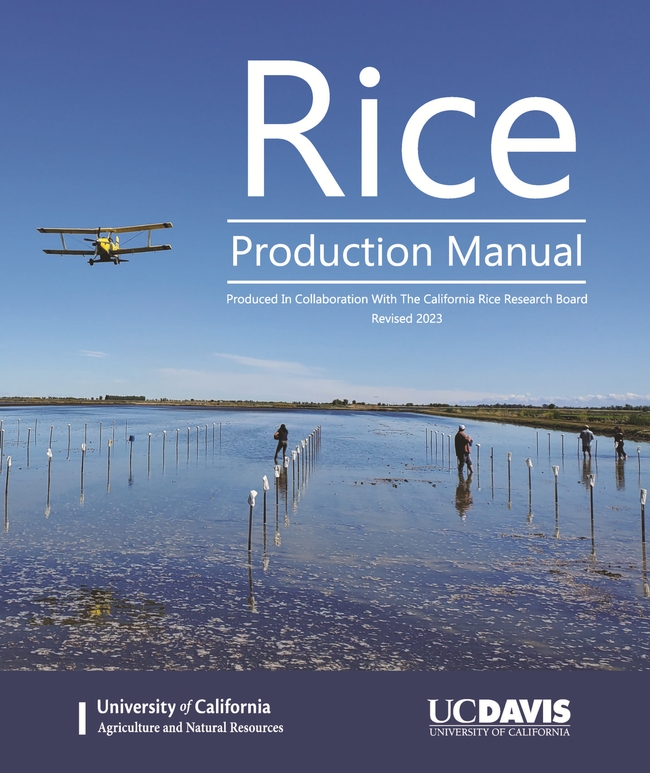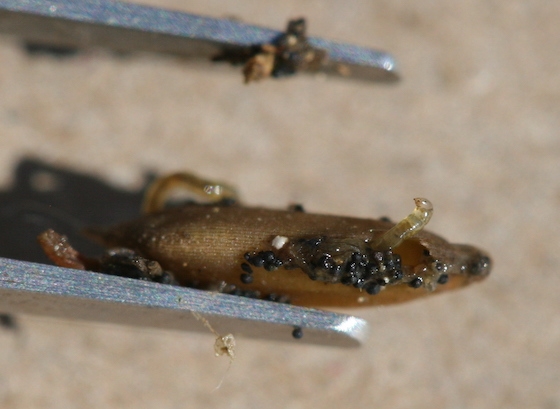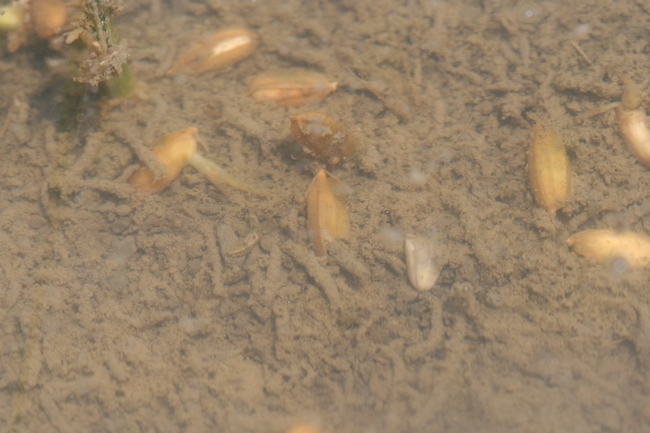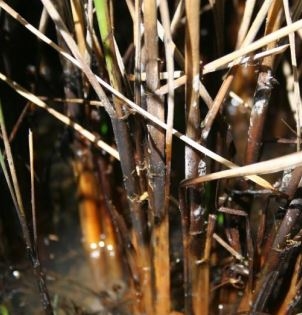- Author: Luis Espino
The 2023 Rice Production Manual is available for download here. The Manual was produced in association with the 2023 Rice Production Workshop; it describes the principles of rice production based on research conducted in the rice production areas of California.
- Author: Luis Espino
I recently visited a field that had quite a bit of rice seed midge injury. In this case, the seedlings that were not injured were almost at the one leaf stage, and one could observe quite a few seeds still in the soil surface. Close inspection of these seeds showed that they had been hollowed out by rice seed midge. Some midge casings were observed as well. Later, I got some reports of more fields injured by rice seed midge in the Colusa area.
|
Seed injured by rice seed midge |
|
Rice seed midge casings and injured seed |
Rice seed midge has been considered a pest of rice for many years. However, it has been an infrequent pest. The thought was that pyrethroid insecticides controlled it. Nevertheless, in the past three years, I have seen considerable injury in fields that had been treated with a pyrethroid.
Ian Grettenberger, UC Davis Entomology Specialist, collected some midges from the field I mentioned above and exposed them to a full rate of a pyrethroid or an insect growth regulator for 48 hours. The larvae survived. We are not sure if the survival is due to low susceptibility or resistance build-up to the pesticides. Ian started doing some pesticide work last year but the results were not clear cut. More work is going to be necessary to improve on the management of this pest. Let us know if you have seen issues with seed midge recently so we can have a better idea of the current importance of this insect.
- Author: Whitney Brim-DeForest
- Editor: Consuelo Baez Vega
- Editor: Taiyu Guan
Coming out of 2022, where roughly half of all California rice fields were left fallowed last year, and others may have been fallowed for two seasons, many of us have questions about what weed management will look like in 2023. While we do not have data on what a 1- or 2-year fallow does to all of our major weed species, we have some preliminary and anecdotal data that might lend some insight.
For small-seeded weeds such as smallflower umbrella sedge, redstem, and ricefield bulrush, the fallow period will likely have no effect. A good anecdotal example is from a field in Davis that was planted for a long time in rice, followed by nothing being planted for over 10 years. Once the field went back into rice, ricefield bulrush was widely distributed throughout the field, and readily emerged. Ricefield bulrush seeds have a thick seed coat, making it easy for them to survive in the soil for a long period of time, and they have a high level of dormancy, increasing their persistence. In an unpublished overwintering experiment with smallflower umbrella sedge to determine if decomposition occurred over the winter in flooded conditions, the smallflower seeds did not decompose. Seeds of smallflower umbrella sedge are also found in the 1,000s per square foot of soil, so once established, they are difficult to get rid of.
For larger seeded weeds including watergrass, a fallow may have an impact, but that impact will likely only be on those weed seeds near the surface of the soil, where they may decompose, and are at increased chance of predation. In a preliminary study conducted last year, we found that in fields where tillage occurred in the spring post-fallow, watergrass emerged, as seeds were brought up from deeper in the soil profile, where they would have remained dormant if tillage did not occur. In fields that were no-till in the spring, in at least one instance, the watergrass did not emerge at the same rate as in the tilled field. Similar results were seen with arrowhead, a perennial aquatic species. The effect of the tillage was to bring up the seeds from deeper in the soil profile, increasing emergence in the tilled area of the field.
At this time, no anecdotal or preliminary data exists for sprangletop. However, due to the small seed size and high dormancy period, it is likely that sprangletop would not be greatly affected by a fallow period and would emerge as normal.
Preliminary data from grower fields that were monitored over three years shows a reduction in weedy rice seed viability in the top 12 inches of soil. However, these fields have not been planted back into rice, so it is unknown whether the reduction of viable seed in the soil translated to reduced emergence.
To summarize, it is unlikely the 1- to 2-year fallows will cause a great reduction in weed emergence, especially for small-seeded species. For larger-seeded species, there may be an impact, which can be increased by use of zero- or reduced tillage in the spring following a fallow period.
"Originally published in Rice Farming, February 2023".
- Author: Luis Espino
- Editor: Consuelo Baez Vega
- Editor: Taiyu Guan
In general, rice diseases are not a big problem in California. However, in some fields, disease pressure can be high and can result in yield losses. One disease that can be found in practically every rice field is stem rot. This fungus causes the tillers to rot at the water level and, when severe, it causes blanking and lodging. In our fungicide trials, we rate the severity of stem rot at drain time using a scale that goes from 0 to 4, where 0 is no disease and 4 is when the tiller is completely rotted. In my experience, when a field approaches an average severity of 2, a yield loss occurs. The problem with this rating system is that it is very time consuming. However, there is a good relationship between severity and incidence, the percentage of tillers that have stem rot symptoms. As severity increases, so does incidence, and when severity reaches a level of 2, incidence is 100%. This means that if you monitor your field at drain time and find that in a random sample of tillers all show symptoms of stem rot, the field is likely at severity level 2 or above and a yield loss may occur.
While this method of evaluating the level of stem rot in your field may help you explain blanking, lodging, and lower yields, it does not help you with the decision to take any corrective action that year. At drain time, it is too late to use a fungicide. I'm currently working on a project trying to determine if we can evaluate stem rot earlier, around the boot stage. In this way, a grower or PCA can decide if a fungicide treatment for stem rot is really needed before reaching the heading stage. Last year was the first year of this project. More years will be needed to provide a recommendation.
A project I have conducted for the past two years looked at the differences between varieties in their susceptibility to stem rot. All our varieties are susceptible, but there are some differences. Varieties with a short cycle, like S-102, CM-101, or M-105 are more susceptible than varieties with longer cycles, like M-209 and M-211. This information might help growers and PCAs improve their disease management program.
As you know, azoxystrobin (the active ingredient in Quadris) is the main fungicide used in rice in California. Many trials have confirmed that we can obtain stem rot severity reduction when applying this fungicide at the late boot to early heading stage. We also tested applying the fungicide at propanil time, but we did not see any benefits of this application timing. In the variety testing mentioned above, stem rot severity was reduced 20-30% when azoxystrobin was applied at early heading (when the first few heads were visible above the canopy). In 2021 this disease reduction resulted on a 4% yield increase. While in 2022 there was no yield increase, we did see increased milling quality in fungicide treated plots.
- Author: Kassim Al-Khatib
- Author: Whitney Brim-DeForest
- Author: Luis Espino
- Author: Ian M Grettenberger
- View More...
This season may be a late-planted one due to the potential for a wet and cool spring. Our research has shown that delayed planting reduces yield potential (yields tend to be about 5 sacks/acre less when planted at end of May compared to beginning of May). Furthermore, late planting push harvest into fall where rains delay harvest, reduce quality and drive up drying costs. Growers do not want to pay for unnecessary costs. In this article we discuss a few items that will help with earlier planting, shorter season and reduced costs.
Land preparation
Land preparation typically starts at the beginning of April when soils are dry enough to open the ground - allowing soils to dry out faster. As we write this in early April, no ground has been opened up and more rain is a possibility. On a positive note, the long wet winter and spring will likely have resulted in better straw breakdown than a typical year. This may make ground work a bit faster and easier and possibly let you get by with one less pass. That said, you do not want to skimp too much on seedbed preparation. Good weed and water management later in the season depend on a good seedbed.
Varietal selection
Good variety selection is key. You want a short duration variety that is cold tolerant. M-206, M-210 and M-105 are good options. The shorter duration will allow for earlier harvest. However, cold tolerance is important as well.
Water management
A late planting date shifts the early booting stage (when rice is sensitive to cool temperatures and blanking) later in the year when night time temperatures are lower. Thus, in addition to proper variety selection, it will be important to raise flood water height to about 8 inches between PI and heading to protect the emerging panicle from the cold temperatures.
Fertility management
Nitrogen rate: You do not want to over apply N. Over application will delay harvest and increase risk of blanking. Given these risks, a shorter growing season, and the reduced yield potential due to late planting, you may consider reducing overall N rate by 5-10% from what you typically apply.
Starter fertilizer: Apply P and K only if needed. If your soil P values are above 15 ppm (Bicarbonate P) or if your soil K values are above 120 ppm, applications of these nutrients may not be necessary. If you do not need P and K then do not apply a starter but rather apply all N as aqua. If applying a starter fertilizer, consider applying 20-30 days after planting. This has several benefits: it eliminates a pass before planting allowing for earlier planting, it reduces scum build up (more likely in a late planted year due to warmer weather), and it can replace the post-herbicide N application that many growers practice.
Top-dressing N: Only top-dress if necessary. A leaf color chart or GreenSeeker is a good tool to determine if it is necessary. Unnecessary top-dressed N increases costs, delays harvest and can reduce yields. Our research continues to confirm that splitting N between a preplant and top-dress N application has no yield benefit compared to applying it all preplant.
Avoid at all costs: You want to avoid a situation where you have N fertilizer in the field and you are not able to flood the field. In wet years, this can be a problem as rainfall may necessitate halting fertilizer applications or other field work after fertilizer operations have already begun. If fertilizer gets wet and you are not able to flood it is almost impossible to figure out how much N is potentially lost. Good planning and checking weather forecasts will help avoid these situations. A couple of days delay in planting is likely better than getting caught in the above scenario which will not only result in fertility management problems but also weed problems.
Weed management
It is likely that the weather will be warmer at later planting dates. Weeds will emerge and grow quickly, due to the warmer temperatures. Late watergrass and early watergrass may emerge before the rice in a flooded field. This means that you will need to be careful about herbicide application timing. It will be important to apply herbicides based on weed and rice growth stages, not based on days after seeding. If applications are made based on the number of days after seeding, they will be applied too late, and this will result in poor control. In general, applications should be as early as possible based on the labeled recommendations for each herbicide. Due to warm temperatures, some herbicides will work better. This will be good for weed control, but the herbicides will also be harder on the rice, causing more phytotoxicity than normal. You may see greater stand reduction with Cerano. ALS-inhibitors (Granite GR/SC, Sandea, Halomax, Londax, Strada, and Regiment) may cause stunting and root pruning especially when applied at early growth stages but the rice should recover. Butte, League MVP, and RebelEX may also cause stunting and root pruning due to the fact that all contain ALS-inhibitors as part of the mix.
Pest management
Late planting will likely result in warmer temperatures during seedling development. Seedling pests like tadpole shrimp (TPS) and rice water weevil (RWW) will develop faster and have the capacity to cause more injury. Under warm weather, TPS will grow and reach a size that can injure rice fast (as quickly as 5 days after the flood is initiated). Germinating rice seeds and seedlings that only have a coleoptile and radicle (no green tissue yet) are preferred by the TPS. Monitor your fields closely during this time and use an insecticide if you see TPS before the rice has any green tissue. Quickly growing TPS means it is easier to miss a problem field or get surprised by TPS.
RWW overwinters in vegetated areas around rice fields and fly to flooded fields during warm and calm nights. Usually the period of RWW flight is extended during several weeks starting in April, but with the current conditions, we might see a more concentrated flight period once temperatures start increasing. If you are in an area with a history of RWW problems, it might be wise to do border treatments soon after the seedlings break the water line.
We are not sure how late planting will affect armyworms. We could see infestations occur when plants are younger than usual, which would make the effect of defoliation more severe. In any case, we will be monitoring armyworm moth flight during the season and will be distributing this information through the UC Rice On-line website.
Blast has not been much of a problem for the past two years. However, looking back at my notes for the 2010 season, when blast was a widespread problem through the valley, I have late planting as one of the factors that probably contributed to the problem. As plants age, they become more resistant to blast infections. Younger plants during weather periods that allow for blast development (warm nights with free water on the leaves) may allow for more infections that can increase incidence (number of plants affected) and severity (how bad the infections are). Managing the crop to limit conditions that favor blast is the best way to prevent infections. To prevent blast, avoid excessive N fertilization, avoid draining the field during crop development, plant the less susceptible variety M-206 or the resistant variety M-210, and avoid plant stresses like nutrient deficiencies, salinity or herbicide injury. If you plant varieties that are less tolerant such as M-209, or M-105, keep a close eye on the field during boot and heading. If infections are detected during tillering, or if we start seeing overcast nights with long periods of dew on the plants before heading, a fungicide application should be made at the very early heading stage to protect from neck blast.
No-till rice
No-till may be a practice that is considered in a late planted year. Since you are not doing tillage work, it has the potential benefits of allowing an earlier planting and reduced costs associated with tillage operations. In addition, weed control costs may be reduced. In previous work at the Rice Experiment Station, we found that yield potential in no-till systems was similar to conventional systems. Here are some things you should consider when practicing no-till:
1. You want to select the proper fields. They should not be rutted from the previous seasons harvest events. The field should not have a straw mat across the surface (i.e. from using a cage roller in the fall), which could impact root penetration. Some standing stubble is not a problem as it helps young seedlings stay in place in case of high winds.
2. If it has rained recently and you CAN see emerged weeds, apply a non-selective herbicide, such as glyphosate to kill emerged weeds. It is recommended to apply glyphosate by ground rig, not by air, to avoid drift issues. Flood fields 24-48 hours after application and seed into the flooded field.
3. If it has not rained recently and you DON'T see emerged weeds, you can:
a. Flood and seed the field, OR
b. If you want to recruit more weeds, you could flush the field with water to germinate weed seeds and then kill these weeds before flooding and planting the field (we call this a stale seedbed). To ensure maximum control, you should wait at least 1 week between the flush and the glyphosate application.
4. Use a higher seeding rate to ensure good stand density.
5. Although the pre-plant glyphosate application should kill most grasses, it will be necessary to follow up with a sedge and broadleaf herbicide at the 3-4 leaf stage of rice.
6. You want to avoid disturbing soil and bringing new weeds to the surface so all fertilizers should be applied to the surface. This means using urea pellets instead of aqua. We recommend applying urea preplant to the soil before flooding. Flooding will help move the urea into the soil. Do not apply urea immediately after flooding. If you do not apply before flooding, you could wait about 3 weeks and apply the urea at that time. Apply starter fertilizer by plane after rice leaves have emerged above the soil surface to avoid scum. You may need to apply a top-dress N application as N fertilizer applied to soil surface is generally not used as efficiently as injected aqua. Use a leaf color chart to help make this decision.
7. Keep water level low in field until roots anchor into soil.







